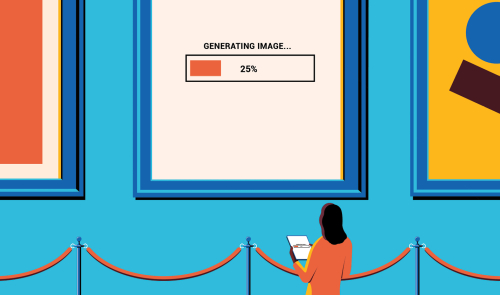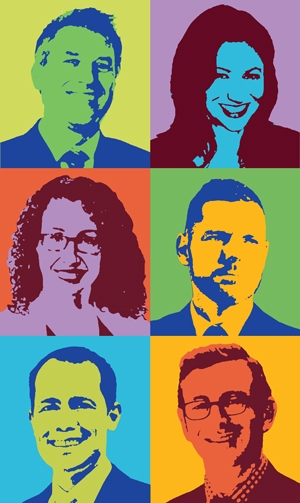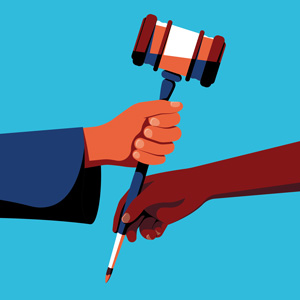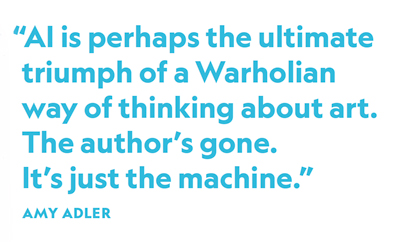Blurring Lines

As intellectual property law and technology evolve, the NYU Law faculty’s IP experts are delving into the many questions that arise when creativity and the law collide.
BY ATTICUS GANNAWAY
ILLUSTRATIONS BY BETH GOODY
In October 2022, Andy Warhol enjoyed a posthumous 102 minutes of fame at the US Supreme Court in oral arguments pitting the Warhol Foundation against rock-and-roll photographer Lynn Goldsmith. The foundation had licensed an image of a Warhol silk screen of the musician Prince—based on a Goldsmith photograph—to appear on a magazine cover in 2016. Goldsmith claimed copyright infringement.
In May, the Court ruled 7–2 for Goldsmith, but said that its decision didn’t address whether Warhol’s painting itself—one of a series of 16 paintings created in the 1980s—was fair use. The Warhol Foundation’s lawyer suggested that a ruling for Goldsmith would “chill the creation of new art by established and up-and-coming artists alike.” On the other side, Goldsmith argued that her creative work shouldn’t be copied without permission. While debate continues as to who was right, intellectual property scholars—as well as figures in the art world—anticipate that the decision will prompt years of renewed uncertainty about fair use.
Meanwhile, the advent of generative artificial intelligence (AI) is also creating tremors in the IP and creative worlds. One example: in September 2022, AI consultant and educator Kris Kashtanova registered a copyright for a short comic book illustrated using images generated through text input. But in February 2023, the US Copyright Office revoked the artwork’s copyright because the images were not created by a human. A new comic by Kashtanova was illustrated by refining hand-drawn sketches with another imaging model. The Copyright Office has not yet weighed in.
Then there are the complexities of another new phenomenon: non-fungible tokens (NFTs), which are associated with artworks but are not art themselves. Rather, they’re tokens existing on and verified by a blockchain—a decentralized digital ledger—that prove the ownership and authenticity of an asset, often a digital file. In the art world, NFTs link to digital images. Among the most expensive NFTs to date is the one for a digital collage by the artist Beeple, which sold at Christie’s for $69.3 million.
How can an intangible token for an artwork that anyone could save to their hard drive be worth tens of millions of dollars? Where does human creativity end and mere machine function begin? Was Andy Warhol an iconoclastic genius or an IP thief? Technological progress has outpaced the law in unprecedented ways and at astonishing speed, leaving legal conundrums in its wake.
At NYU Law, a group of IP experts is focused on unraveling the tangled threads at the heart of these quandaries and anticipating what could come next. Christopher Jon Sprigman, Murray and Kathleen Bring Professor of Law, is among the faculty members who have explored how innovation is fostered both within the law and outside it, even as technological advances complicate the narrative. “Every creative community has an innovation ecosystem,” says Sprigman. “Some of them are dependent pretty heavily on IP rights, and some of them are really not. It’s not like the story about IP doesn’t make any sense. It’s just that it’s not the same story all the time, and it’s not even the right story some of the time.”
The Supreme Court’s story about Warhol was a convoluted one. The Copyright Act of 1976 codified the four factors used to determine fair use. As argued at the district and circuit levels, the Warhol case hinged on the first and fourth factors: the purpose and character of the use, and the effect of the use upon the potential market for the copyrighted work. The Warhol Foundation asserted that the Prince Series sufficiently transformed Goldsmith’s photograph and also appealed to a different market than hers. But the foundation asked the Supreme Court to rule only on the first factor, which it did—sort of.
Holding that the 2016 magazine cover violated Goldsmith’s copyright—but declining to rule on whether Warhol’s Prince Series was fair use—the Court focused primarily on the commerciality of the use, downplaying the question of how Warhol had changed the original image. The justices have “[diminished] the importance of inquiry into creativity that the first factor had previously enshrined,” Emily Kempin Professor of Law Amy Adler says—effectively shoehorning fourth-factor considerations into first-factor analysis.
While the Court attempted a narrow ruling on a single licensing question, Adler worries that the question of fair use, already complicated, is now even murkier. She points out that fair use in copyright law isn’t a bug but a feature. The trade-off for copyright protection is allowing other creators some room to copy and transform even protected works. With the Warhol ruling, artists may decide the increased uncertainty is too risky.
“Copying is a technique that belongs to everyone, and that artists of all types have used for hundreds of years,” says Adler. “Michelangelo was copying. Allusion, emulation: it’s not just about Warhol and pop artists and appropriation artists. This is the stuff of art history, and to imagine that people can create from whole cloth without drawing on the past is, in my view, naive.”
The Warhol case propelled to the forefront legal issues that Adler has been contemplating for years. In her 2016 article “Fair Use and the Future of Art,” she argued that the heavily emphasized transformative test in fair use law introduced in a 1990 article by Judge Pierre Leval—then serving on the Southern District of New York—was inadvertently quashing rather than promoting creativity. The second work, Leval asserted, should add value to and entail a different purpose from the original.
“The transformative test poses a fundamental threat to art,” Adler writes, “because the test evaluates art by the very criteria that contemporary art rejects.” Many current artists, she explains, employ copying as the foundation of their works, erase the artist’s very identity, and reject traditional notions of visual art. Further, Adler asserts, different courts diverge in assessing transformations. Contemporary artists such as Richard Prince, Jeff Koons, Shepard Fairey, and Banksy have been entangled repeatedly in copyright cases, with inconsistent outcomes. The 2023 Warhol ruling likely won’t elucidate matters.
Adler’s most recent scholarship makes the Warhol affair look quaintly old-school. In a new article, she tackles NFTs and other perplexing phenomena in the realm of “artificial authenticity.” In “Memes on Memes and the New Creativity” (2022), co-written by Adler and Walter J. Derenberg Professor of Intellectual Property Law Jeanne Fromer, the authors explain that an NFT “manufactures ersatz uniqueness to counteract a world of limitless reproduction.”
Reproductions and questions of authenticity definitely interest Fromer, a repeat collaborator with Adler. She has decorated her office with art that relates to her past scholarship. On one wall hangs an enlarged inkjet print on canvas of an Instagram post: a selfie of a blue-haired woman in a Star Wars stormtrooper costume. The piece invokes Adler and Fromer’s 2019 article, “Taking Intellectual Property into Their Own Hands,” which looks at ways in which creators seek relief outside the legal system for unauthorized appropriation. One example involved a series of works by Richard Prince, which he created by commenting on other people’s Instagram posts and printing enlargements on canvas. The works sold for $90,000 to $100,000. The SuicideGirls, an online community of pin-up models, retaliated by adding their own comment—“true art”—on five of the images, and sold identically formatted canvas prints for a mere $90. (Prince applauded their move.)
Also in Fromer’s office is what looks like a Gucci baseball cap, except instead of the double-G Gucci logo, it has a double-B logo, for Balenciaga—the result of a collaboration between the two fashion houses. Fromer discusses this partnering in her new article “Trademark Ownfringement,” which examines a growing phenomenon in which, Fromer writes, “trademark owners have increasingly been acting very similarly to those they accuse of infringement or dilution of their marks…. Were a third party to have done this, Gucci and Balenciaga would reasonably be shouting about consumer confusion and trademark infringement.”
Ownfringement, Fromer says, extends also to unprecedented collaborations between wholly unrelated businesses—Adidas shoes with Lego brick detailing or Velveeta-scented nail polish—and self-parodies, such as Gucci’s purposely misspelling its own mark (“Guccy”) and Nike’s misplacing its trademark swoosh logo on its sneakers.
Fromer suggests that owners could be rendering their own marks less distinct and even engaging in self-dilution. Additionally, the increased likelihood of consumer confusion about whether a trademark is being used legitimately affects the traditional analysis of trademark infringement. If trademark owners themselves muddy the waters, will they have an easier or a harder time proving likelihood of confusion in instances of genuine infringement?
Fashion offers an intriguing example of an area of vibrant creativity and high commercial value where copyright is much less relevant, since fashion designs cannot be copyrighted under US law. Adjunct Professor Douglas Hand JD/MBA ’97, co-founder of fashion law boutique Hand Baldachin & Associates, counsels his clients—and through his published articles, the broader fashion industry—to pursue trademark protection vigorously.
“The brand is a very protectable element of IP, whether that’s a logoized form of the brand name, logos themselves, a red sole [on a Christian Louboutin shoe], and/or the brand name,” Hand says. “And so we do really encourage brands to lean into their trademark portfolio and think long and hard about what are signifiers that are consistent of their brand, because that’s source-identifying and therefore trademark.”
Moses H. Grossman Professor of Law Scott Hemphill has explored this lack of copyright protection in two different pieces with co-author Professor Jeannie Suk Gersen of Harvard Law. In “The Law, Culture, and Economics of Fashion” (2009), they argue that fashion designs should have limited protection against close copying but that looser emulation should be permitted, to facilitate the perennial phenomenon of spreading fashion trends while still respecting designers’ intellectual property.
In another piece in 2014, they looked at how an organization of fashion houses fought piracy extralegally in the 1930s by collectively boycotting stores selling copied designs, until their anti-piracy efforts were ultimately trust-busted by the Federal Trade Commission and the Supreme Court. Connecting that past effort to present-day initiatives, Hemphill and Gersen write, “Today’s proposals to add fashion design to federal copyright law continue to spawn debates about whether and to what extent designers do or should want protection from copying.”
In their 2012 book, The Knockoff Economy: How Imitation Sparks Innovation, and other writings, Sprigman and co-author Professor Kal Raustiala of UCLA School of Law argue that the de facto “license to imitate” arising from lack of copyright allows the fashion industry to thrive creatively. The absence of copyright spurs constant innovation, they suggest, as designs are copied and proliferated, thus creating and then exhausting trends—what they call the “piracy paradox.” The authors apply this notion to other highly creative fields such as stand-up comedy, cuisine, and software.
Sprigman, like Adler and Fromer, has recently been exploring questions of authenticity. In a new article co-authored with Professor Stefan Bechtold of ETH Zürich, Sprigman considers how, in a world of ever-easier reproduction technologies, producers of both artisanal and mass-manufactured goods attempt to give consumers an “auratic experience,” imbuing objects that might otherwise be considered commodities with a “halo of preciousness” typically reserved for artworks.
IP is often a key part of the strategy as the product’s backstory becomes part of the product itself. A Burgundy wine must originate from the Burgundy region of France, and a California wine producer runs afoul of the law if it labels a wine “Burgundy-style,” even if it uses the same grapes and methods of the Burgundy tradition.
Sprigman and his co-author also consider the NFT, musing that it could be viewed as a “Veblen good,” which is desirable as a way to attain status: “The cost is the point.” An NFT, they suggest, is “a status good, relevant mostly within a crypto-aware subculture, which references an artwork as a signal of connoisseurship but actually dematerializes the act of consumption.”
NFTs—and the complex issue of what it actually means to own them—are the latest manifestation of existing IP debates examined by Professor of Clinical Law Jason Schultz in The End of Ownership: Personal Property in the Digital Economy (2016), co-written with Professor Aaron Perzanowski of the University of Michigan Law School. The co-authors consider the troubling implications of those eye-glazing license agreements consumers blithely skip reading when they buy a digital music album or e-book. Buyers aren’t free to lend or sell the product, as they could with a physical book or CD. In one ironic example, Amazon remotely deleted e-book copies of George Orwell’s 1984 from users’ devices in response to a rights dispute.
Modern license agreements, Schultz and Perzanowski write, impinge on the public’s ability to consume artistic creations and other products through private regulatory schemes. “Licenses effectively rewrite the balance between creators and the public that our IP laws are meant to maintain,” the co-authors say. “They are an effort to redefine sales, which transfer ownership to the buyer, as something more like conditional grants of access.”
In his Technology Law and Policy Clinic, Schultz and his students tackle legal work aimed at these complicated IP issues and others. They are advising two clients who created a graphic novel that imagines a dystopian alternative future following a successful January 6 insurrection. It entails potential legal issues such as right of publicity claims from characters who may or may not resemble real-life news media figures. Corporate brands appear because of their owners’ connection to the Trump administration, with possible trademark implications. “[Our clients] are selling the graphic novel,” says Schultz, “but they’re also having a message about politics, about culture, about education, about thinking through how important this issue of the election was.”
The stunningly swift growth of generative artificial intelligence has generated litigation just as swiftly. A copyright class-action suit filed last January targets the companies behind the image-generation tools Stable Diffusion, Midjourney, and DreamUp, which translate text inputs into images. The models on which the tools are based, the plaintiffs allege, were trained with copyrighted images lifted from the internet. Around the same time, Getty Images sued the developer of Stable Diffusion, claiming that the generative AI tool had been trained with millions of Getty’s stock images without proper licensing. Further legal battles are a virtual certainty.
At an NYU Law Forum in April, moderated by Schultz and sponsored by Latham & Watkins, Adler discussed the US Copyright Office’s recent attempts to “parse and separate out the difference between machine authorship and human authorship.” These questions aren’t new, Adler said, pointing to the quandaries posed by the invention of photography in 1839. Photos were seen as being “authored by half-man, half-machine,” Adler said. “Who was the author of a photograph?”
Outside the Forum, Schultz and Adler both invoke the “monkey selfie case,” in which a nature photographer allowed wild macaques to photograph themselves with his equipment. The Copyright Office denied the application to copyright the photos due to nonhuman authorship. After the photographer published the images, People for the Ethical Treatment of Animals sued him on behalf of the macaque, seeking unsuccessfully to establish that an animal could hold a copyright.
Generative AI is now raising similar issues, says Schultz: “There’s this moment at which human beings are asking machines and technology to help them be creative, and we have two problems in the law that are trying to get worked out.” The first is determining at what point asking a machine for help negates one’s IP rights. The other, he says, is deciding how to recognize “the shoulders of the giants that art stands on.”
Once again, all roads lead to Warhol, who anticipated these sorts of developments decades ago, Adler says: “Is there a human author there somewhere?… That’s a question that Warhol made interesting and started asking well before AI. Warhol said, ‘I want to be a machine.’”
In their 2022 article, Adler and Fromer assert that memes—digital images, created by combining visual media with captions, that are disseminated online—upend conventional wisdom on copyright by deriving value through, not despite, being widely copied, typically without attribution. “The authorlessness of the meme function could be said to be very Warholian,” says Adler, “and now AI is perhaps the ultimate triumph of a Warholian way of thinking about art. The author’s gone. It’s just the machine.” Accordingly, Adler recently began work on a paper exploring perhaps the most foundational query in art: “What is a human?”
As daunting as these questions are, IP law still valiantly strives to illuminate these profound philosophical challenges. How do we distinguish art from commerce, person from program? “We live in the post-postmodern world,” says Adler, “where that blurred boundary is now the ground upon which we stand.”
Atticus Gannaway is senior writer at NYU Law.
Posted on September 11, 2023




